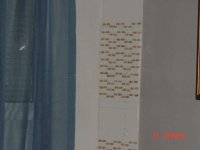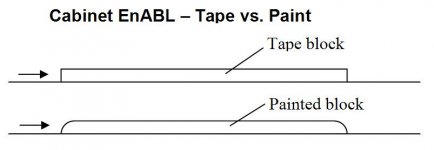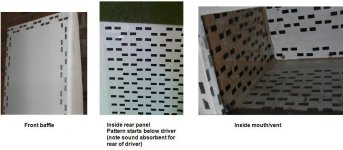Alex - the painted pattern on the Planet10 Fonken boxes were applied by Bud; he simply beat us to it. I'm not sure if he similarly treated the F120A Fonkensteen enclosures for Jim Rebman.
As suggested previously, my impression of the effect being "more subtle than the EnABL treatment on the cones", was based on almost 2 years of continuous listening to at least 6 different pairs of this enclosure design, with a range of drivers and treatment levels.
With a very narrow front baffle / beveled profile, and flush mounted driver, I think this enclosure design already has a fairly benign diffraction signature. Subjectively this is certainly the case compared to our test pair of more conventionally dimensioned enclosures with the same volume and tuning (i.e. the GR Fonken). The beveled enclosures seem to pull off that "disappearing" act more then the rectangular ones.
A lot of pixels have been spent discussing /analyzing various existing and proposed measurement methodologies to identify what is going on in/around the moving speaker cone due to the EnABL treatment - an issue that is possibly a long way from conclusive resolution.
It could also be very interesting to investigate the effect that treatment to the baffle and adjoining exterior panels would have on polar dispersion / power respsonse patterns, etc., and morevover, if/ how any noted changes to those patterns might be related to the perception of "soundstage , dimensionality, increased coherence of levels of inner detail" etc., that are part of the enhanced musical experience I know I'm getting from the cone treatment.
As suggested previously, my impression of the effect being "more subtle than the EnABL treatment on the cones", was based on almost 2 years of continuous listening to at least 6 different pairs of this enclosure design, with a range of drivers and treatment levels.
With a very narrow front baffle / beveled profile, and flush mounted driver, I think this enclosure design already has a fairly benign diffraction signature. Subjectively this is certainly the case compared to our test pair of more conventionally dimensioned enclosures with the same volume and tuning (i.e. the GR Fonken). The beveled enclosures seem to pull off that "disappearing" act more then the rectangular ones.
A lot of pixels have been spent discussing /analyzing various existing and proposed measurement methodologies to identify what is going on in/around the moving speaker cone due to the EnABL treatment - an issue that is possibly a long way from conclusive resolution.
It could also be very interesting to investigate the effect that treatment to the baffle and adjoining exterior panels would have on polar dispersion / power respsonse patterns, etc., and morevover, if/ how any noted changes to those patterns might be related to the perception of "soundstage , dimensionality, increased coherence of levels of inner detail" etc., that are part of the enhanced musical experience I know I'm getting from the cone treatment.
chrisb said:It could also be very interesting to investigate the effect that treatment to the baffle and adjoining exterior panels would have . . . .
I guess it is only a question of time before somebody will apply the dotted patterns to furniture and other interior objects.

Svein
Svein_B said:
I guess it is only a question of time before somebody will apply the dotted patterns to furniture and other interior objects.
Svein
You might be funning with me, of course, but clearly the poorly worded quoted phrase could be misconstrued. I meant the baffle in which the driver is mounted (could of course be an open baffle), and the other (adjoining) surfaces of the speaker enclosure itself.
Possibly to everyone's horror, here is a room treatment begun by a man possessed. Not me either, he is of Fostex F200 A fame, from the split EnABL threads. Perhaps we can someday get him to voice his opinions on the benefit or lack thereof. Not the only surfaces he is working on either.....
Bud
Bud
Attachments
chrisb said:Alex - the painted pattern on the Planet10 Fonken boxes were applied by Bud; he simply beat us to it. I'm not sure if he similarly treated the F120A Fonkensteen enclosures for Jim Rebman.
As suggested previously, my impression of the effect being "more subtle than the EnABL treatment on the cones", was based on almost 2 years of continuous listening to at least 6 different pairs of this enclosure design, with a range of drivers and treatment levels.
With a very narrow front baffle / beveled profile, and flush mounted driver, I think this enclosure design already has a fairly benign diffraction signature. Subjectively this is certainly the case compared to our test pair of more conventionally dimensioned enclosures with the same volume and tuning (i.e. the GR Fonken). The beveled enclosures seem to pull off that "disappearing" act more then the rectangular ones.
G'day chrisb,
I agree with you that the more benign the diffraction signature is to begin with, the less dramatic the change when compared with say a rectangular flat baffle.
Your description of the effect is based on experience with the painted pattern on Fonken designs only.
However, Bud has applied the painted pattern to many different cabinet designs and yet he describes the effect as "subtle".
soundsinthestix used tape and found the results to be a "very noticeable difference" - which concurs with my experience.
An interesting thought - tape blocks would have a squarer edge, whereas painted ones (applied using a calligraphy pen) would be more like a roundover. See pic.
- - - - - - - - - - - - - - - - - - - - - - - - - - - - - - - -
G'day Bud,
That looks like the pattern inside my Voigt pipes.
I'll try and get some pics later today or tomorrow.
Cheers,
Alex
Attachments
BudP said:Chops,
That is an excellent question. In the various formats I have tried and have also been tried in commercial systems the foam and felt were somewhat successful in controlling some emission problems, but it always seemed to be a reduction of the problem with reference to the signal heard rather than a solution to the problem. There were always more losses than gains from my experiments. Radiation patterns became slightly less focused but transient information seemed less intelligible. there was a bigger sweet spot but drums cymbals, stringed instruments and spatial definition noises became thuds scratch sounds and very anechoic respectively.
Putting the EnABL pattern on reduces the tonal based beaming and provides what is usually on axis only balances across the included angle of a cone driver and quite often wider than that. At the same time eliminates all of those room nodes, provides spectacular amounts of coherent low level information for spatial reproduction and removes rather than subdues emission characteristics that limit intelligibility.
Sounds like hocus pocus to me too, trust me. The only way you can actually know what to think is to participate. Get a kit from Ed LaFonntaine, open up a boom box and treat the drivers to a minimalist set of patterns. Then you will know.
Bud
Hello Bud!
What if you were to leave about an inch or two of bare baffle on all sides of the driver's basket frame to EnABL, then cover the rest of the baffle beyond that point with felt/foam, or even leather? Or do you think that would still kill the overall sound?
-Charles
Hi Charles,
Honestly I have no idea. The EnABL patterns should work as usual, regardless of what you do to the surface. At least that is the way it works out, on the driver faces.
You can certainly experiment without actaually commiting yourself to anything. Use a reduced tack tape like the blue tape sold by 3M for paint masking. Cut the patterns sized to what Alex has shown with his calculator and then listen to just that.
Once you have a pretty good idea of what to expect from various forms of music, regardless of whether you actually like what you are hearing, use some thin applications or rubber cement and tack the felt or foam in place.
Listen to that for a while and then remove the EnABL pattern pieces and repeat the journey. Then pull the felt and listen bare again.
Then do it again and this time take notes, both on the changes you found and what you thought of them.
At that point you will be one of the experts and your level of knowledge about baffle control will likely exceed mine. Just as Alex's fund of knowledge about baffles and bass loading apertures exceeds mine.
Suits me to a tee!
Bud
Honestly I have no idea. The EnABL patterns should work as usual, regardless of what you do to the surface. At least that is the way it works out, on the driver faces.
You can certainly experiment without actaually commiting yourself to anything. Use a reduced tack tape like the blue tape sold by 3M for paint masking. Cut the patterns sized to what Alex has shown with his calculator and then listen to just that.
Once you have a pretty good idea of what to expect from various forms of music, regardless of whether you actually like what you are hearing, use some thin applications or rubber cement and tack the felt or foam in place.
Listen to that for a while and then remove the EnABL pattern pieces and repeat the journey. Then pull the felt and listen bare again.
Then do it again and this time take notes, both on the changes you found and what you thought of them.
At that point you will be one of the experts and your level of knowledge about baffle control will likely exceed mine. Just as Alex's fund of knowledge about baffles and bass loading apertures exceeds mine.
Suits me to a tee!
Bud
Alex from Oz said:G'day chops,
Why wait? Just EnABL the cardboard boxes!
Cheers,
Alex
Hey Alex,
Don't think the idea didn't already cross my mind! LOL
Didn't someone here mention something about a calculator for adapting the EnABL process to enclosures? If so, I can play around with that and these cardboard boxes some more while I try to come up with a plan for real enclosures for my FE126eN's.
-Charles
Didn't someone here mention something about a calculator for adapting the EnABL process to enclosures?
pphhhwwww... that would be cool

where can i find it
sincerely
lilmik

Originally posted by chops ...while I try to come up with a plan for real enclosures for my FE126eN's.
Hi chops, have you chosen an enclosure yet?
Chops, my suggestion is to mount them on stands, as a pair, without any baffle at all. Use a stack of business cards to support the magnet and a piece of thin packing foam as the top of stand cover, with the basket edge close to the front edge of the stand, just to get the face upright and facing you. Then sit and listen. You will not like the FR balance at all. Just ignore this for a while. Instead listen to how open and unencumbered the sound is. Get up and walk around the drivers while listening, notice how good an omni driver they are.
Then begin to think about how to add another driver, to an open baffle that holds these, nude, as omni drivers. !0 inch alnico Tone Tubby, EnABL'd and rolled off at about 300 hZ with a simple LC filter crossover to the 126's would be my first choice here. However, you can get a fully boxed driver to mate with these, as an omni driver, with appropriate box EnABLing.
Please trust me here, an EnABL'd driver does not perform like any other sort of driver in these circumstances and no box will be better than an open baffle, which will be better than a closed box. Using the three in a step from omni to open baffle to subwoofer, all EnABL'd, would be ideal.
Just a suggestion from someone who has tried it and was delighted with the results, as cobbled together and poorly made as they were.....
Bud.
Then begin to think about how to add another driver, to an open baffle that holds these, nude, as omni drivers. !0 inch alnico Tone Tubby, EnABL'd and rolled off at about 300 hZ with a simple LC filter crossover to the 126's would be my first choice here. However, you can get a fully boxed driver to mate with these, as an omni driver, with appropriate box EnABLing.
Please trust me here, an EnABL'd driver does not perform like any other sort of driver in these circumstances and no box will be better than an open baffle, which will be better than a closed box. Using the three in a step from omni to open baffle to subwoofer, all EnABL'd, would be ideal.
Just a suggestion from someone who has tried it and was delighted with the results, as cobbled together and poorly made as they were.....
Bud.
The nude drivers are just a suggestion for how to go about deciding what sort, if any, enclosure to provide. Again, this is how I work with a driver I am treating, regardless of how many of them I have done previously, unless I have a fully engineered solution, box, crossover, driver placement and drivers used. In those instances, of which there have been around 200, I treated the entire system as just that and made decisions about pattern placement and amount of gloss coating used, based on overall system fit.
For my part, I learn more about a driver when it's shortcomings are not band aid covered by a supporting baffle. My thought is that if the driver works as I am interested in hearing, with great clarity, near infinite resolution, a lack of "false" response to musical signals and an ability to provide substantial and correct imaging, then it should work with a supportive enclosure of any sort, better than if I had used a particular baffle or enclosure and the results were skewed to fit that particular instance.
For my personal interest, even though my music reproduction system speakers.enclosures are from Planet 10 and I am extremely satisfied with them, I would prefer an omni mounted driver, sitting on top of and with a minimal amount of loading from, an open baffle. That to be combined with a mid woofer on the open baffle and a transmission line loaded woofer, to fill out the range from 300 Hz to 20 Hz.
Heretical as this notion is I do think it provides a more musical presentation than anything I have heard to date, with respect to fidelity in tone, presentation as a reproduced sound field, with a singular ability to provide solid instruments within groups of equally solid instruments, regardless of the sonic density of the musical information.
Bud
For my part, I learn more about a driver when it's shortcomings are not band aid covered by a supporting baffle. My thought is that if the driver works as I am interested in hearing, with great clarity, near infinite resolution, a lack of "false" response to musical signals and an ability to provide substantial and correct imaging, then it should work with a supportive enclosure of any sort, better than if I had used a particular baffle or enclosure and the results were skewed to fit that particular instance.
For my personal interest, even though my music reproduction system speakers.enclosures are from Planet 10 and I am extremely satisfied with them, I would prefer an omni mounted driver, sitting on top of and with a minimal amount of loading from, an open baffle. That to be combined with a mid woofer on the open baffle and a transmission line loaded woofer, to fill out the range from 300 Hz to 20 Hz.
Heretical as this notion is I do think it provides a more musical presentation than anything I have heard to date, with respect to fidelity in tone, presentation as a reproduced sound field, with a singular ability to provide solid instruments within groups of equally solid instruments, regardless of the sonic density of the musical information.
Bud
chops said:Didn't someone here mention something about a calculator for adapting the EnABL process to enclosures?
If you haven't already found it EnABL block size calculator
Cheers,
Alex
- Status
- This old topic is closed. If you want to reopen this topic, contact a moderator using the "Report Post" button.
- Home
- Loudspeakers
- Full Range
- EnABLed speaker baffle



